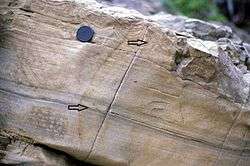Flame structure


A flame structure is a type of soft-sediment deformation that forms in unlithified sediments. The weight of an overlying bed forces an underlying bed to push up through the overlying bed, generally when both strata are saturated with water. The resulting pattern (in cross section) may resemble flames. In order for the flame structure to occur, the overlying bed must be of a higher density than the underlying bed, or there must be differential pressures in the upper bed.[1][2]
Basically prior to flaming these structures are unstable,[3] under pressure,[1] and then subject to additional stress, such as being triggered by earthquakes.[4] Earthquakes over magnitude 6 can initiate flaming in large (hundreds to thousands of square kilometres) areas, but flaming can also be caused by as little as the repeated pounding of waves.[5]
References
- 1 2 Anketell, J. M. et al. (1970) "On the deformational structures in systems with reversed density gradients" Rocznik Polskiego Towarzystwa Geologicznego (Annals of the Geological Society of Poland) 40: pp. 3–30
- ↑ Collinson, John D. (1994) "Sedimentary deformational structures" pp. 95–125 In Maltman, Alex J. (editor) (1994) The Geological Deformation of Sediments Chapman and Hall, London, ISBN 978-0-412-40590-7
- ↑ Owen, G. (1996) "Experimental soft-sediment deformation: Structures formed by the liquefaction of unconsolidated sands and some ancient examples" Sedimentology 43(2): pp. 279–293
- ↑ Brodzikowski, K., and Haluszczak, A. (1987) "Flame structures and associated deformations in Quaternary glaciolacustrine and glaciodeltaic deposits: Examples from central Poland" Geological Society of London Special Publications 29(1): pp. 279–286
- ↑ Long, D. (1993). "The Burgsvik Beds, an Upper Silurian storm generated sand ridge complex in southern Gotland, Sweden". GFF. 115 (4): 299–226. doi:10.1080/11035899309453917.